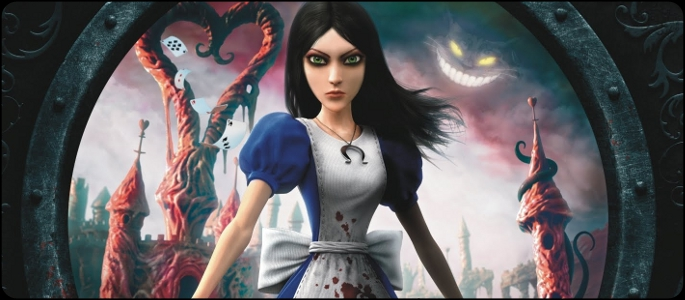It’s been a long time since American McGee’s Alice released in 2000, but the sequel is finally here. American McGee’s development studio Spicy Horse has taken the reigns again to lead us through the insanity that is Alice: Madness Returns, and it’s time to find out if it’s crazy fun, or coma inducing boredom.
While Alice may have overcome many trials and tribulations in her first outing to American McGee’s darker version of Wonderland, it seems that she still has many inner demons to overcome. Madness Returns starts immediately after its predecessor, with Alice having moved into an orphanage where she is under the care of Dr. Bumby. Despite having reformed enough to be released from the asylum, she still sees hallucinations and has nightmares about the tragic fire which killed her family so many years ago. Dr. Bumby is trying to help her forget the past, and move on, but his methods aren’t working, and it isn’t long before she slips back into the madness of a chaotic Wonderland in despair.
The opening of most of Alice: Madness Returns’ six chapters start with Alice in Victorian London, making for a drab initial setting and Alice looking downtrodden in her gray dress. Walking around London gives a sense of the unexciting and primarily uncaring world around her, which isn’t helping recovery from her traumatic experiences. Alice has a very restricted move set during these sections, which are very short but do a good job of establishing the connection of the real world to Alice’s hallucinations and mental aberrations. It was implied in the original Alice game that various characters in Wonderland represented not only Alice’s emotions, but people she knows from real life. Now they’re drawn into the story line, even if for the majority of it you’ll be just as confused as Alice is throughout it. When Alice inevitably journeys to Wonderland we’ll not only make a connection between her mental states, but appreciate the color and escape of Wonderland, even if it is warped into a perverse state.
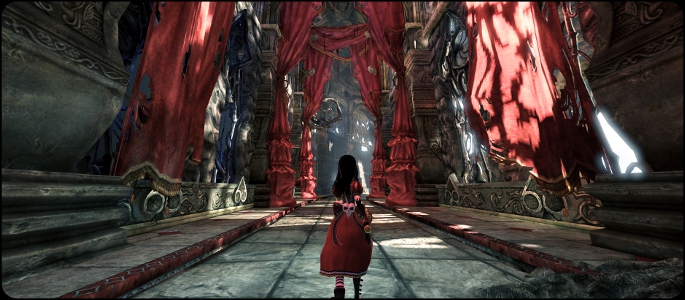
When Alice first enters Wonderland she arrives in the Vale of Tears, where a green forest surrounds a river and flowing waterfalls, with a nice view overlooking a cliff. The beauty of Wonderland is evident here, but it won’t last long, as progression leads into a twisted and demented form of the realm. While the art direction and design of these environments and characters are great, the graphical fidelity is hit and miss for much of the game. Certain objects and areas look really great, but then you’ll notice a platform and walls with bland textures, appearing to have been stretched out over too big of an object, or other textures popping in and out as you approach characters and objects. Some chunky frame rates occur too, usually when the game loads a collected memory. Alice herself looks great though, with flowing hair reacting to movement and jumps alike, and costumes that change to match the landscape as the game progresses. Most of enemies look decent too, but several NPCs simply lack detail, and have rough polygonal appearances.
Luckily for Alice and players of the game alike, her agility and combat skills have improved significantly while in Wonderland. It doesn’t take long for Alice to get back into the groove of using her unique Wonderland powers, specially provided by her imagination, and she is triple jumping across chasms and floating to slow her decent, then dodging quickly to evade enemy attacks. Her Vorpal Blade returns to her side to provide quick combo melee attacks, and later the trusty Hobby Horse provides heaver club like swings to smash enemies back into an oily puddle of sludge. A pepper grinder provides her with machine gun like support from a distance, and later a very special teapot lets launch a steaming hot ball of tea across the room to scald insidious opponents from afar. Alice can also place rabbit shaped bombs in the field, which distract enemies and eventually explodes, and can also be used to hold down pressure plates to solve simple puzzles.
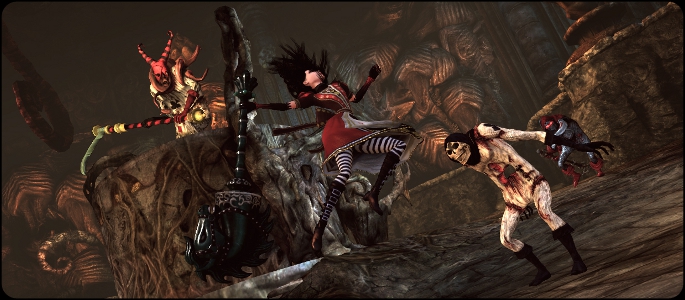
The weapons at hand aren’t plentiful, but each serves a specific purpose and are useful against certain enemies. Of course, things start off simple, facing only one enemy type at a time, and slowly more are introduced until large battles are encountered, where quick decisions of what to kill first and how make all the difference. This is also where one of Madness Returns’ biggest problems rears its ugly head. A lock on camera is necessary to use the long range weapons effectively, but it has a horrible tendency to get stuck while characters move around, forcing the player to lose their target in order to reposition the camera. It by no means breaks the game, but can be extremely annoying when trying to tack a particular foe within a swarm of enemies. Luckily a special Hysteria Mode can be activated when health gets low, rendering Alice invulnerable and extremely powerful for a short time and turning the world black, white, and red, Sin City style. Killed enemies usually drop health, and this move can be repeated often, saving the day if a sloppy camera gets in your way.
When not in combat Alice can also shrink temporarily when the player pulls the left trigger, allowing her to access to new areas through keyhole shaped tunnels. Shrink also bestows “shrink sense,” showing Alice obstacles and pathways previously unseen, since being smaller makes all the large things so much more noticeable. The special vision is used frequently throughout the game, primarily to jump across sets of invisible platforms, often times moving back and forth to make it all that much more difficult to get across. It’s a bit daunting when hopping from one unseen platform to the next, miles up in the sky with nothing but floating playing cards and clouds surrounding you, but it also provides a bit of a fresh mechanic to the well established platforming genre. Shrink sense also shows Alice hand drawn pictorials, which often point out hidden memories, bottles, pig snouts, and which way important characters are.
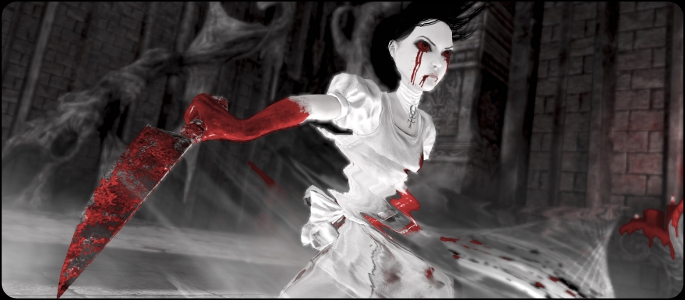
Wonderland is full of hidden items too, which are often hidden in clever or deceiving ways, making the use of shrink sense incredibly frequent. Of the more clever hidden items are floating pig snouts (sometimes mounted on walls), which quietly snort until a blast of the pepper grinder initiates a forceful sneeze. The snouts usually open up a hidden path, and provide some valuable teeth as a reward. Teeth act as currency in the game, allowing for upgrades of each of the four main weapons. Collecting memories plays back an audio snippet from Alice’s past, while bottles unlock artwork in the main menu. I’m usually not one for collectibles, but the huge number of them and various ways of hiding them actually made it fun to hunt most of them down.
Madness Returns’ 15-17 hour long campaign packs a decent length to the game, but the lack of evolving gameplay past the half way point makes the last half start to feel monotonous, despite the changing landscape. By the time you’re about halfway through the game you’ll have acquired all of Alice’s abilities and weapons, leaving the rest of the game with purchasing the rare upgrade to increase damage. While it’s cool too see the weapon designs change with upgrades, the fact that the rest of the game relies on the occasional new enemy, or more often just a different mixture of them, makes battles start to feel old by the end. Platforming takes a similar turn, in that it becomes increasingly more complex to navigate, but always boils down to the same triple jumping and flipping switches to open up new paths.
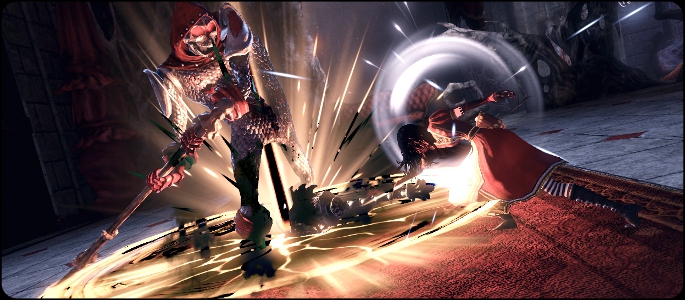
Numerous mini games of varying types help break the repetitive sections up, but not enough to make it more entertaining when they’re done. Some of the mini games are clever however, and they’re definitely welcome, since it’s fun to have a quick 2D platforming romp through a painting, or fight sharks off with an underwater boat in a sidescrolling battle. Later you can also roll around as a doll’s head, or just smash your previously threatening foes to bits as a giant version of Alice. Some mundane “chess” puzzles also break up the pace, but to my disappointment the chess pieces are merely place holders for an unrelated puzzle.
While I applaud Alice: Madness Returns for a lengthy campaign, solid gameplay mechanics, entertaining combat, with some visual appeal, I simply can’t ignore the few noticeable faults riddled throughout it. The storyline failed to draw me in, perhaps because it was confusing for one half, and painfully obvious for the second. Between this, the incessantly annoying lock on camera, and a lacking character progression after half way through the game, I found myself coming out of it a bit disappointed. Even though New Game+ is available after completion, there isn’t much replayability to the game, except to clean up finding the last of the hidden objects. The inclusion of the original American McGee’s Alice with new copies helps make up for a some of this, giving many the opportunity to experience a classic game that’s become a rare and expensive collectible over the years. Overall, Alice: Madness Returns is a moderately fun action-adventure title that creates an interesting, albeit confusing experience to play through, which just needed a little more polish, spark, and character progression to make it great.
PlayStation LifeStyle’s Final Score – Sloppy camera work – Snail-like character progression leads to monotony |
 |
–
